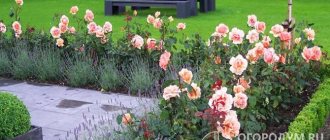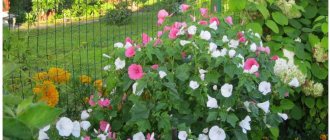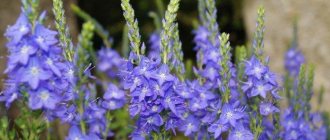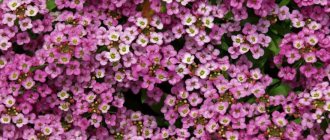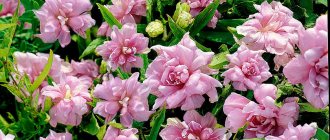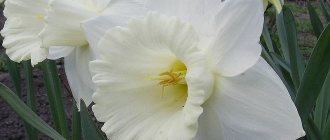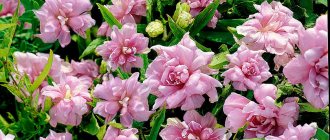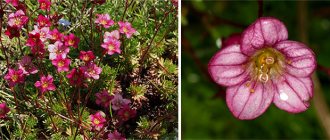The herbaceous plant poppy (Papaver) is a member of the Poppy family. This genus includes more than 100 species. The homeland of this plant is considered to be Southern and Central Europe, Australia and Asia. Poppies are naturally found in regions with temperate, subtropical and cold climates. They also prefer to grow in dry places, for example, in deserts, steppes, semi-deserts, and also on rocky and dry slopes. This flower is cultivated as an ornamental and medicinal plant. In a number of countries, poppy cultivation is prohibited, since most of its species contain narcotic substances. In some countries, poppies are grown on an industrial scale to produce opium, which is extracted from unripe pods. Opium is used as a raw material for the production of painkillers and sleeping pills.
Already in Ancient Rome it was known that poppy had healing properties; at that time, opium, or more precisely, its hypnotic effect, was studied. There is information that the scientific name of this plant was derived from the Latin word “papa”, translated as “father”, this was explained by the fact that to calm a restless crying child, poppy seeds were added to his food.
In the Muslim countries of Asia Minor in the Middle Ages, the consumption of alcohol was prohibited; instead, opium was smoked there. Over time, this tradition became widespread in eastern countries, and today China is the largest consumer of opium. The Chinese government in 1820 introduced a ban on the import of intoxicating poison, but after some time, when the “opium” war with England was lost, the import of opium was again allowed. The fact is that England had enormous profits from the supply of this product to China. Today, the cultivation of soporific poppy is carried out in India, Asia Minor and Central Asia, China and Afghanistan. And decorative poppies, as well as their hybrids, are popular among gardeners. This plant can often be seen in rock gardens or flower beds.
Description and features
Plants are herbaceous annual, biennial and perennial crops with a powerful taproot system and single straight shoots. Their foliage is arranged alternately, pinnately dissected, slightly prickly due to the edge and can grow up to 30 cm.
The buds of the crop are large in size, most often of a single type with red, white or yellow colors. The flowers are located on a long peduncle or peduncle (stemless variety), there are no bracts, some have a paniculate inflorescence.
The flowers have numerous stamens with thin or expanded club-shaped filaments at the top. The anthers are either rounded or linear; in rare cases, there is a capitate appendage on the ligament. There are 3-20 or 4-10 carpels in the ovary.
Poppy flowers are pollinated by insects; self-pollination is observed in some species.
Bud color options
Chemical characteristics
The chemical characteristics of plants of the genus Papaver have been studied quite well. Probably everyone has seen how, after damage to a green poppy head, a liquid is released, the so-called jelly of the poppy. This substance is known as opium, which contains more than 30 alkaloids. The most important of them:
- morphine (20%);
- noxapine (5%);
- codeine (2%);
- papaverine (2%);
- thebaine (1%).
In 1803, the alkaloid morphine was obtained from raw opium, and in 1874, heroin was obtained by treating morphine with acetic anhydride. At one time, some pharmaceutical companies used morphine in drugs for coughs, chest pain and pneumonia. This practice was then abandoned as it became known that such drugs were addictive.
Today, the most widely used opium alkaloid is codeine. This substance is obtained in several ways: from natural sources, as a result of methylation of morphine, or in the process of synthetic transformation of thebaine.
But besides these substances, the poppy plant contains fiber, protein, nitrogen, calcium, phosphorus, iron, iodine, manganese, copper, magnesium, sodium, potassium, zinc, B vitamins and some other useful components.
Nutritional value of poppy seeds (per 100 g)
| Calorie content | 525 kcal |
| Carbohydrates | 28.13 g |
| Squirrels | 17.99 g |
| Fats | 41.56 g |
| Cellulose | 19.5 g |
| Vitamin B1 | 0.854 mg |
| Vitamin B2 | 0.1 mg |
| Vitamin B3 | 0.89 mcg |
| Vitamin B5 | 0.324 mg |
| Vitamin B6 | 0.247 mg |
| Vitamin B9 | 82 mcg |
| Vitamin C | 1 mg |
| Vitamin E | 1.77 mg |
| Sodium | 26 mg |
| Potassium | 719 mg |
| Calcium | 1438 mg |
| Copper | 1.63 mg |
| Iron | 9.76 mg |
| Magnesium | 347 mg |
| Manganese | 6.7 mg |
| Phosphorus | 870 mg |
| Selenium | 13.5 mg |
| Zinc | 7.9 mg |
Is it possible to grow a plant from seeds?
How to grow poppy? All varieties of the crop can be propagated by seed.
Various species are suitable for growing from seeds:
- peony, tangled, changeable, gray, bare-stemmed or saffron, peacock - annual variations;
- Alpine, Amur, grayish, Atlantic, Lapland, Scandinavian - perennial.
The reproduction process is simple; flowering is observed already 60 days after the first shoots peck.
For perennial plant varieties, separate vegetative techniques can be used.
Poppy shoots
Benefits of poppy seed oil
In the 19th century, poppy seed oil was used as a “raw material” for lamps, a food product, and also a raw material for the manufacture of paints. Today this product is also widely used in the food and pharmaceutical industries, in the production of varnishes and paints. It is one of the components for the treatment of malignant tumors, hepatocellular carcinoma. As a food product, it is added to sauces, as a healthy fat, and used to make salad dressings. The advantages of this product include the fact that it is practically incapable of going rancid, and the content of opiates in it is even lower than in ripe seeds.
Growing Strategies
The crop is included in the list of herbaceous plants and reacts negatively to attempts to replant it. Experienced gardeners recommend sowing at the future growing site.
The seedling method is used occasionally, when poppy is used as a potted plant or to form a certain accent on the site.
Annual varieties
When to plant poppies? Annuals are sown with the arrival of spring or in mid-autumn; the choice depends on local climatic and weather conditions. For the southern regions, preference is given to March, for the central part - April.
Sowing takes place in rows, without deep deepening. The first young are expected in 7-14 days. It is thinned out, leaving individual representatives 0.2 m apart from each other. It is recommended to carry out planting work maintaining a distance of 10 cm when planting seeds.
Annual varieties are destroyed after the buds wither. If the gardener wants to prolong the flowering time, then he needs to remove the seed pods as they form. Failure to trim the seed plants will result in self-seeding the following spring.
With the onset of autumn, the garden plot must be cleared of plant debris and carefully dug up.
Growing at home
Two-year-olds
Usually, sowing poppies before winter is delayed until the last moment. When planted early, seed material can germinate even in cooled soil - you need to choose the right time so that it does not have time to wake up before the onset of winter cold. The soil should have time to freeze in the upper layers; the best time is November.
If the soil temperature is 3-5 degrees, then planting work is not carried out.
In the spring, the procedure takes place after the snow has melted and the soil has thawed. The planting process is standard, it does not depend on the time of work and is carried out according to a certain step-by-step algorithm:
- The soil is prepared in advance or immediately before planting (it is dug up and loosened).
- During soil cultivation, weed roots are removed.
- Organic fertilizer and a mineral mixture are applied - for 10 kg of organic matter, 50 g of mineral fertilizers are taken, the calculation is made for each square meter.
- In the fall, rows 2-3 cm deep are created in the areas of future sowing; in the spring, planting is done superficially or in furrows.
- The seed material is laid out with a gap of 5-20 cm in order to prevent thinning of young growth in the future.
- Winter crops are covered with a thin layer of earth on top, without excessive deepening, spring crops are lightly sprinkled with soil, and plastic film is used to accelerate germination.
- The procedure ends with watering.
After planting in spring, stable soil moisture is maintained for 14 days. The film must be removed when the first greens are pecked.
Germination of seeds planted in late autumn occurs the following spring, after the earth has warmed up to 3-5 degrees. The first shoots will appear in 10-20 days. Young animals are characterized by increased cold resistance, but if the temperature drops more than 5 degrees, they are additionally protected with a shelter made of non-woven material.
If planting was carried out too often, then it is necessary to thin out the seedlings. Initially, create a distance of 10 cm between individual shoots, later it is increased to 20 cm.
Chaotic landing
Perennial
A very interesting question: how to plant perennial poppy. For some reason, beginner lovers of colorful flowers think that the procedure should be very different. In fact, the process of planting perennials is no different from working with biennial plants.
It is preferable to place seed material at a constant growing point immediately.
Poppy diseases
In general, poppies are fairly easy to grow. But sometimes diseases can “catch on” to it - powdery mildew or downy mildew. Powdery mildew begins as a whitish coating on the leaves of a plant. Then it disappears, and black or brown dots (the body of the fungus itself) appear in its place. As soon as you notice alarming signs on poppy leaves, the flowerbed should be treated with a solution of copper oxychloride (40 g of oxychloride per 10 liters of water). An alternative option for getting rid of powdery mildew is spraying with a soda solution (30 g of soda per 10 liters of water).
The same “medicines” should be used to combat downy mildew – downy mildew. This disease looks somewhat different: brown spots immediately appear on the leaves, and the leaves themselves become deformed. After some time, the stems and lower parts of the leaves become covered with a purple coating.
To avoid diseases and degeneration of the plant, poppy should be sown in a new place every year: planting in one place can be repeated no less than after 3 years.
Features of plant care
If the planting process took place in the spring, then until the crop gets stronger, it is protected from drought. Additional watering has a positive effect on adult representatives and those planted in autumn days.
The main thing in this matter is not to create excessive soil moisture; it is enough to prevent the soil from drying out.
If the poppies have grown very tall or the garden plot is constantly exposed to the wind, then the stems are tied to supports as they grow.
Even during the first winter period, the crop does not need additional shelter. The soil must be loosened and fertilized - in the spring or up to 3 procedures during the season.
With proper care, the plant will delight you with lush buds
How to collect poppy seeds. MAIN MAGICAL PROPERTIES OF POPPY IN MAGIC
Among many peoples, the poppy is now a symbol of fertility, oblivion, idleness and a cheerful life without worries. The red flower is a symbol of beauty, happiness, success and relaxation.
This is the ability to bear children, prosperity, luck and success in business, protection from all kinds of evil, amulet, resolution of love problems, viewing the future and much more.
Use of poppy seeds as a talisman:
- Carry a small amount of poppy seeds with you and put them in your child's backpack. This is guaranteed to protect you from troubles and accidents.
- When you make a variety of amulets for yourself and your home, add these wonderful seeds. This will enhance the effect many times over!
Oh, how the evil spirit is afraid of these seeds! Sprinkle some seeds in the corners of all rooms and leave them for exactly one day. Make sure no one touches them, especially small children!!!
After a day, sweep it up with a broom and throw it in the toilet. While rinsing with water, say: “As the poppy disappears and dissolves in water, so all my problems and illnesses disappear and dissolve.” Give thanks.
It is VERY effective to wash off the poppy with water, since it is the element of water, and water can work with it most “skillfully”.
- If you have to go into a company that is obviously unpleasant, where there will be people with whom you would not like to meet (gossipers and chronic pessimists), pour some grains into your right sock. Protection from the evil eye, damage and other troubles is guaranteed!
Is it uncomfortable and can you feel the grains on your foot? What is more important to you: to endure a little temporary discomfort or to “attach” a sea of negativity to yourself? We are confident that you will make the right choice.
- If you have your own farm and livestock, then after the cow calving, scatter a small amount of poppy in the barn. This will protect both the cow and the newborn calf from disease and pestilence.
- You can also use these miracle seeds to protect your garden from crop failure. To do this, take just a few seeds and place them on your right palm, move them in a circle clockwise three times, ask the poppy to protect your harvest, thank them and blow them to the ground. Rest assured that this will be the case. This is a very ancient method that has been tested by many in practice in our times.
Alternative propagation methods
Any type of plant, annual or perennial, reproduces by self-sowing. This ability is used by designers to create a natural accent and a variety of bright areas in the overall composition.
If the appearance of poppies in an unexpected area is undesirable, as is its gradual migration through the garden, the seed pods should be removed before they are completely ripe. Otherwise, spontaneous scattering of seeds will occur.
Propagation by roots is rarely used
In the literature there is information about dividing and rejuvenating the crop, and for perennial varieties, digging and dividing every three years is recommended. Experts perceive such reports with great doubt.
The plant denies transplantation processes; they are carried out in exceptional cases when poppies are in danger of death. In this case, this does not mean complete separation, but the separation of some shoots and rosettes that appear in spring and summer. This is an acceptable approach to reproduction, although the children take a long time to take root and it is very difficult.
There are attempts to propagate the crop using root or green cuttings; cuttings of the root system are sold along with seeds:
- In the first option, they are cut from taproots into pieces up to 5 cm in length and 5 mm in thickness. The sections are treated with crushed charcoal and dried. Later they are sent into the ground for rooting, leaving a third above the soil surface. Minimum sockets appear in a short period of time at standard humidity levels. After the cuttings have taken root and sprouts have formed on them, they can be sent to a designated location.
- Parts of the stem with leaves are cut from underdeveloped branches that appear towards the end of August. Rooting is carried out in constantly moist soil under a hood.
Sowing time
Poppy seeds must be cold-treated before germination. Therefore, there are two temporary options when you can sow poppy seeds in open ground:
- in cold soil - at the end of autumn or at the end of winter;
- into warmed ground - in March-April (preliminary “hardening” will be required, described in more detail below).
As for choosing a planting site, it should definitely be in the sun: poppies do not bloom well in the shade. This plant loves light, fertile and well-drained soil. Either black soil or sandy loam soil is suitable for it.
Use in pharmacology
In modern pharmacology, derivatives of opium alkaloids continue to be used in the manufacture of analgesics, drugs against cough or diarrhea. Medicines containing poppy extract are used to relieve severe pain, as stimulants, inducing euphoria and relieving anxiety. Medicines of this type are effective in treating stomach cramps and spasms in the respiratory system. Codeine and morphine are components of sedative and analgesic drugs that often have antispasmodic properties. Codeine is also used as a cough suppressant. Papaverine relaxes muscles and improves cerebral blood flow.
Other painful conditions for which preparations with poppy plant extract help: colds, fever, inflammation, colic, colic, enterocolitis, dispersion, nausea, hypertension, migraine and other types of headaches, hysteria, insomnia, mania, ulcers, warts, malaria, cancer, bites, caries. But abuse of such drugs can become addictive.


